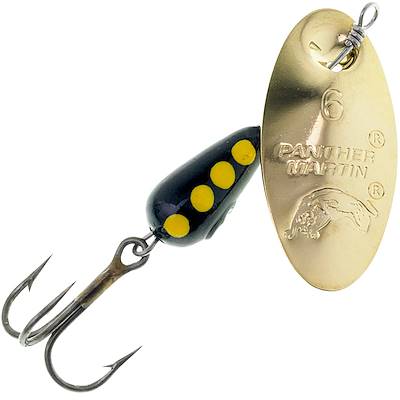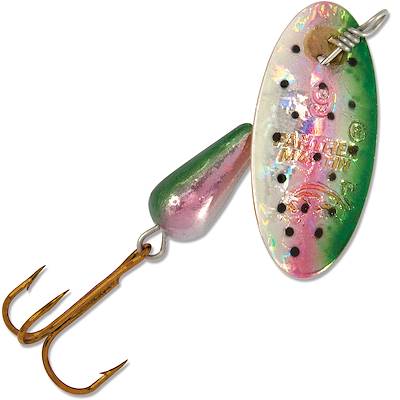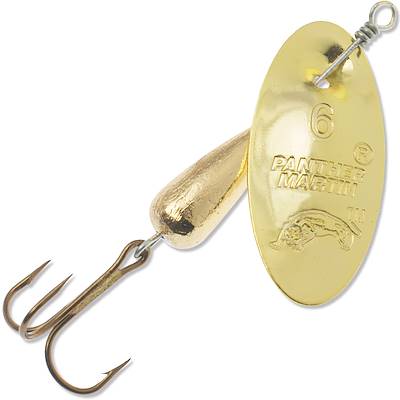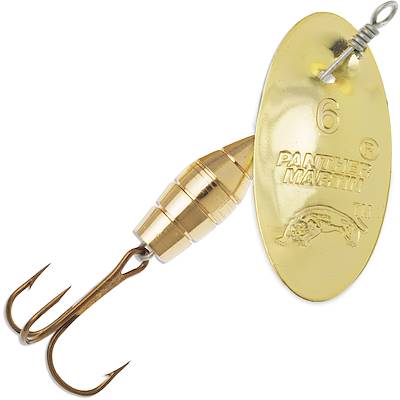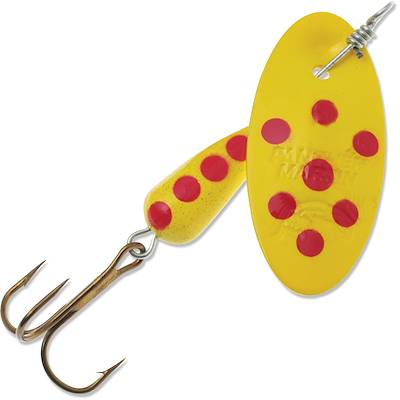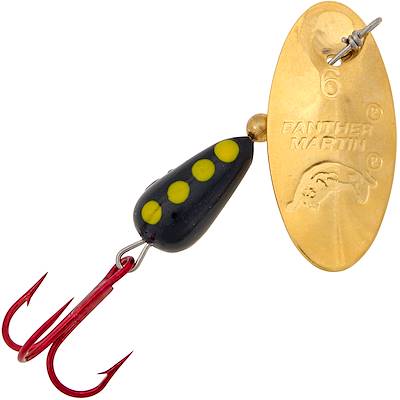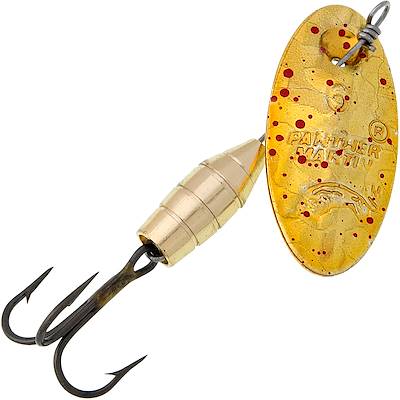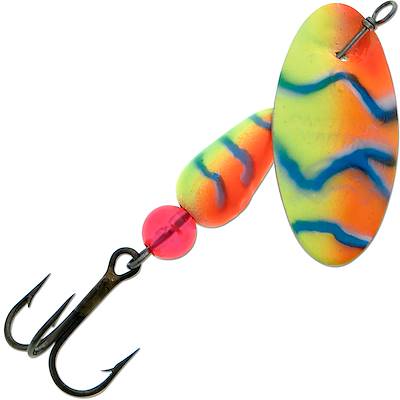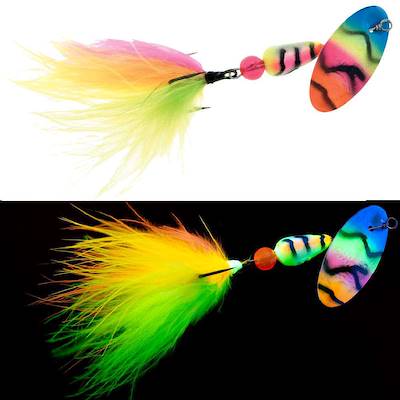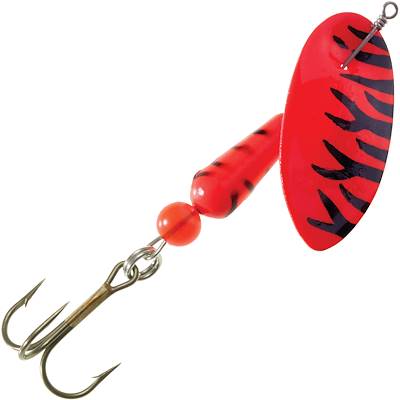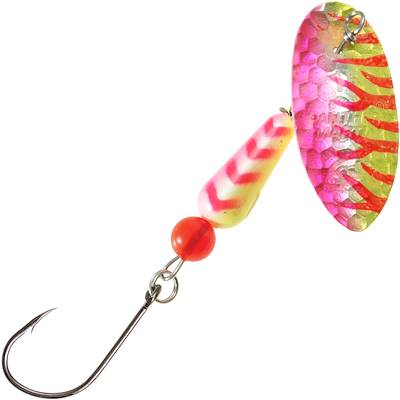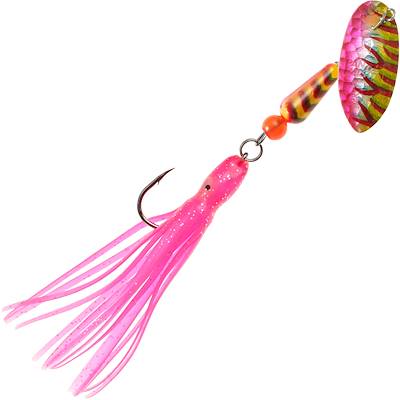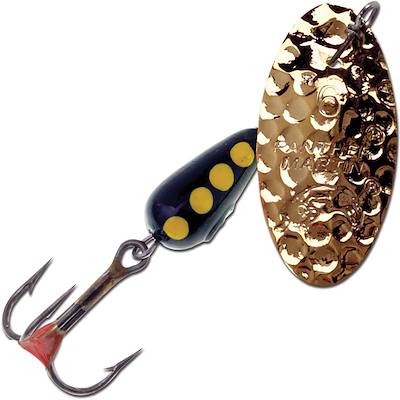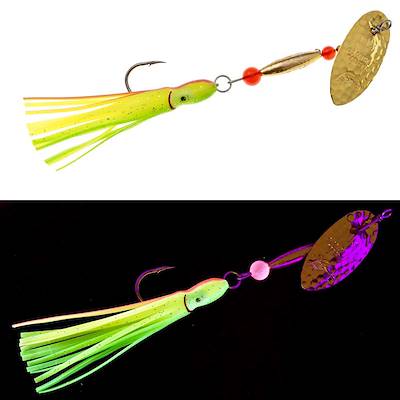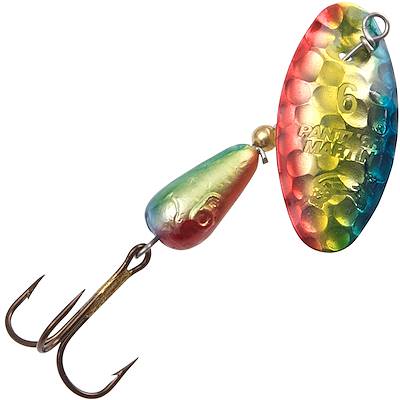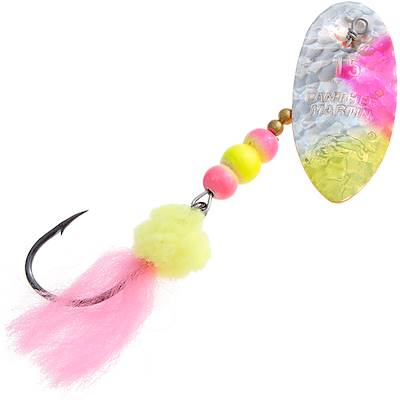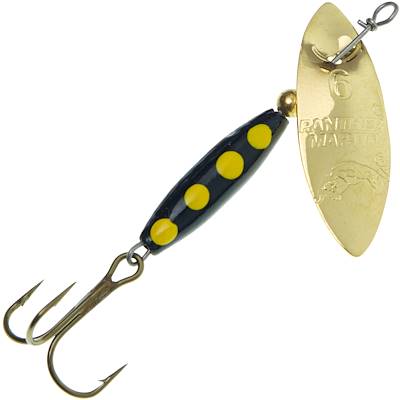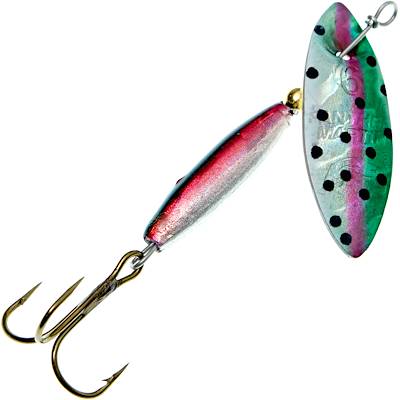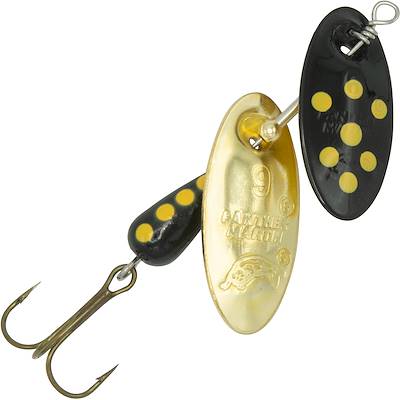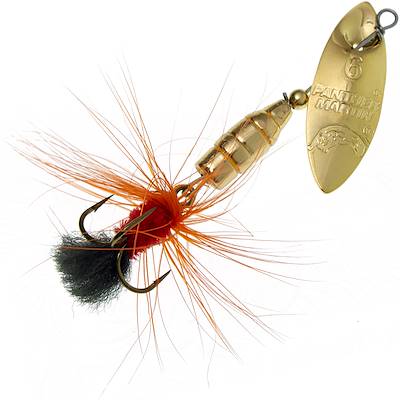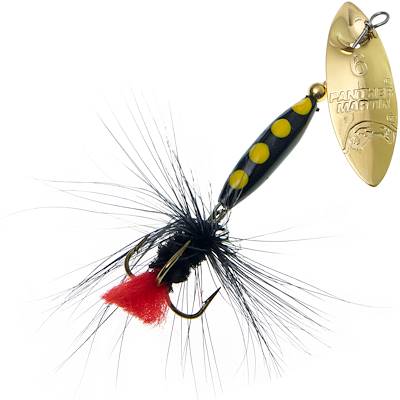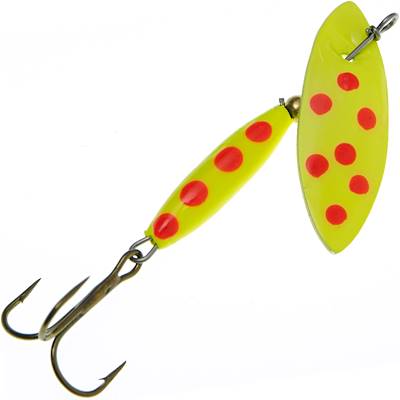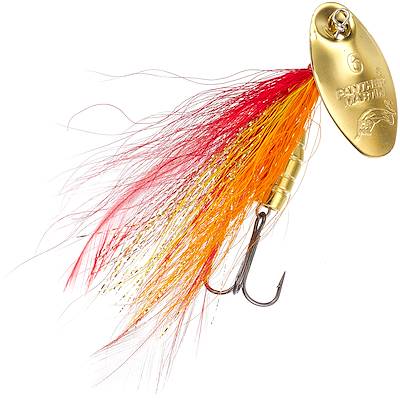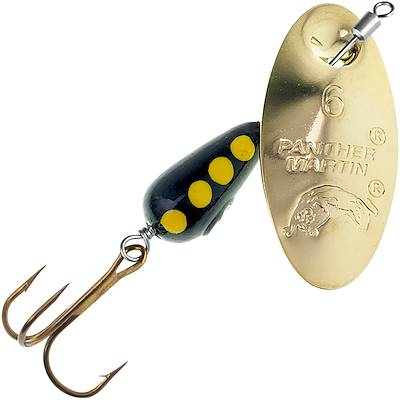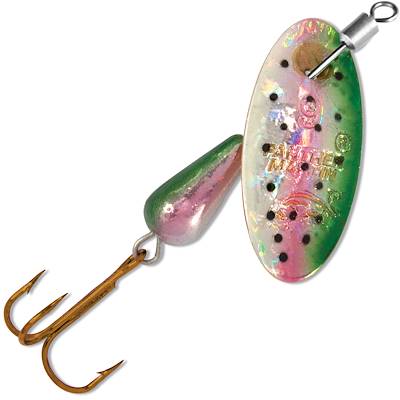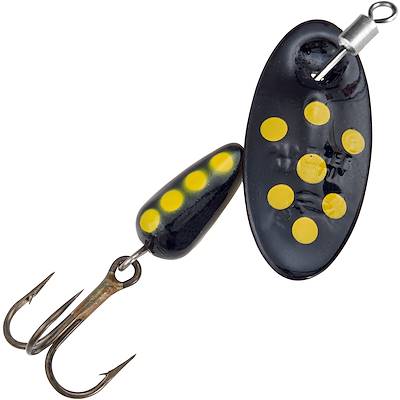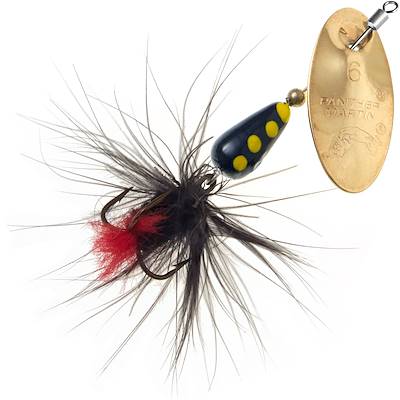Panther Martin Salmon & Steelhead Fishing Guide
Salmon & Steelhead
Introduction
The various salmon species and steelhead trout are closely related in that both are anadromous fishes, meaning they are born in freshwater, run out to sea for several years, then return to their birth waters to spawn. While the term truly applies to coastal species that made the transition from freshwater to saltwater, both salmon and steelhead have been widely stocked in large freshwater systems like the Great Lakes, resulting in additional localized runs from big open freshwaters up connecting rivers, creeks and streams.
A favorite target of anglers wherever they occur, both salmon and steelhead grow large, fight hard and taste great. They are often caught in the same waters but there are some significant differences in their life cycles, favored environments and lure presentations to which they are most receptive. For starters, most salmon that enter rivers on their spawning run will die once their task is completed. Steelhead, on the other hand, can spawn annually and exit rivers to return to their favored feeding waters. Salmon do not feed upon commencement of their spawning run and, as such, must be aggravated into striking. Steelhead trout, by comparison, continue to feed and will strike out of hunger or aggression. Both require cool, highly oxygenated water with temperatures of 64 degrees or less to thrive. While various salmon species begin their spawning runs in the summer and fall, steelhead runs generally peak during the winter months.
Salmon species that will smack spinners include chinook (king), koho (silver,) pink (chum,) Atlantic, kokannee and sockeye. Steelhead are actually rainbow trout that lose their bright colors in favor of silver flanks as they enter rivers, streams and creeks.
General Tips
- Under normal conditions both salmon and steelhead prefer large spinners. Use sizes 9 - 18 as a starting point for steelhead trout and sizes 12 - 20 for salmon. Use the smaller sizes in the clearest water.
- As a general rule, both salmon and steelhead react best to bright, highly visible spinners that put out a lot of vibration.
- Since spawning salmon are no longer feeding they must be provoked into striking. The combination of Panther Martin’s vibrant @Html.LureGroupActionLink("FishSeeUV Salmon & Steelhead", 103) colors and unmatched sonic vibrations are the keys to solid strikes.
- Steelhead trout tend to favor fast-flowing runs while salmon find softer currents and backwater eddies more appealing.
- Spinners tend to be most effective for salmon and steelhead where the fish are found in water depths of five feet or less.
- The stronger the current in a river, stream or creek, the more slowly you’ll need to retrieve. Keep your spinner close to the bottom to optimize your time in the strike zone.
- In rocky waters, use a short, snap of the wrist at the start of each retrieve to "pop" a spinner off the bottom to avoid snags and get the spinner blade turning properly.
- In snag infested waters, tie lures straight to a braided main line without using a monofilament or fluorocarbon leader. This allows you to pull hard enough to straighten the hook and free a snagged spinner. Replace the treble when you get home.
- Both steelhead and salmon respond well when twitches and direction changes are added to the retrieve.
- Salmon and steelhead may run large, but not all strikes are vicious. Learn to feel the thumping, pulsing vibration of your Panther Martin spinner blade. If the pulsing rhythm suddenly stops or the lure feels slightly heavy, set the hook because a fish has likely swallowed the spinner while moving toward your direction. This phenomenon is known as a "slack line bite."
- In exceptionally rocky waters, it pays to swap out the treble hook on your Panther Martin @Html.LureGroupActionLink("Salmon & Steelhead", 103) spinner with the single siwash hook supplied.
- While salmon occasionally stray across currents to inhale a spinner, presentations to steelhead need to be spot-on as they rarely stray out of established feeding lanes.
- For fishing shadow lines, especially in the evening, choose a brightly colored Holy Hammered spinner in size 9 or 15. Holy Hammered Brookie, Pink Lady, and Rainbow Brite are especially productive patterns an hour before sunset. You can also use these patterns if steelhead and salmon shy off brilliant FishSeeUV colors.
Match the Hatch
- Bright, light colored spinner patterns like Panther Martin’s @Html.LureGroupActionLink("FishSeeUV Salmon & Steelhead Marabou", 103) in UV Red White or UV Chartreuse Lime Orange work especially well under bright skies in clear waters.
- Under cloudy skies and in low light conditions, vibrant darker colored blades and bodies excel for steelhead and salmon. Try a Panther Martin’s @Html.LureGroupActionLink("FishSeeUV Salmon & Steelhead", 103) spinner in UV Red Tiger, UV Pink Tiger or UV Fire Tiger.
- Although both salmon and steelhead will strike at any time of the day, catches in clear water situations tend to be best during periods of low light. Fish mornings, evenings and under heavy cloud cover.
- It’s important to carry a selection of Panther Martin spinners in a wide array of colors. Oftentimes, once two or three fish have been pulled from the same pool of clear water, a color change is needed to keep drawing strikes.
- Salmon and steelhead often follow spinners for long distances before striking. Be ready for a last-second pounce as your lure gets close to the shore or boat. A late twitch or direction change can trigger a jolting strike.
- Panther Martin’s @Html.LureGroupActionLink("FishSeeUV Salmon & Steelhead", 103) spinners in UV Red White are especially provoking to mature king salmon in clear water.
- Soak a Panther Martin FishSeeUV Salmon & Steelhead Marabou spinner in salmon egg juice or other fish attractant scent for added steelhead appeal.
- Work spinners slowly in fast-flowing, discolored water. If possible, keep the lure in place for 30 seconds or more at the head of a substantial pool.
- After holding your spinner in place for several seconds, simply change the rod angle to slide your lure slightly left or right. Hold it in place for several more seconds before beginning the retrieve.
- Since it is hard to see a strike in stained water, keep your rod tip angled down toward the water. This will allow plenty of room for a sweeping set of the rod should you be surprised by a sudden strike.
- Panther Martin @Html.LureGroupActionLink("FishSeeUV Salmon & Steelhead", 103) spinners in UV Red Tiger and UV Pink Tiger work especially well in shallow waters for pink or sockeye salmon.
- Adding a slight jigging motion to your retrieve will sometime entice reluctant silver salmon and steelhead trout to strike.
- Once stream and river waters begin to look murky, concentrate your efforts on working slow-moving eddy and pocket water. Work each pocket or eddy in stages, concentrating on the headwaters first and moving deeper toward the tailwaters with each successive cast.
- Go bright in turbid waters where fish have trouble seeing. @Html.LureGroupActionLink("Chartreuse-lime-orange", 103, "PMSSTUV", "CLO") or UV Pink Tiger spinners, combined with Panther Martin’s superior vibrations, provides a solid start.
- Shore fishermen find that waters clear-up near shore before they do in main currents. While muddy water may shut down the boat fishery, shore anglers can score tight to the bank. Steelheads, especially, will migrate toward clean water.
- In rushing, turbid stretches, tie a size 9 - 15 spinner straight to a braided main line. The extra sensitivity of the braid will better transmit the pulsating rhythm of the spinner blade up the line allowing you to feel if the lure is working properly. Since underwater visibility is minimal, the braid should not discourage shy lunkers.
- Work your spinner slowly in fast-flowing, turbid water. If possible, keep it in place for several seconds at the head of a pool.
- To sweeten the pot for steelhead, add an egg sac to the hook of a Panther Martin FishSeeUV UV Pink Tiger, UV Lime Tiger or UV Chartreuse Lime Orange spinner in size 12 or 15.
- Although most anglers target salmon and steelhead in rivers and streams, staging fish can be caught in open water adjacent to river and inlet mouths during early spring. The bright colors, flash and vibration of Panther Martin spinners provide anglers a big edge when early season water is slightly discolored.
- In lakes and marine waters, big salmon and steelhead will feed on locally abundant baitfish and even cannibalize their own kind. A Panther Martin Deluxe Holographic Red Hook Rainbow Trout spinner in size 9 or 15 can work especially well in waters where rainbows are stocked on a regular basis.
- Silver blades work well in deeper, open waters. Try a Panther Martin Dressed White Feather All Silver Red Hook spinner in size 9 or a Panther Martin Dressed Salmon Egg in size 9 around a river mouth to tempt spring lunkers or salmon and steelhead staging just prior to their spawning runs.
- Troll slowly with Panther Martin spinners using opposing color patterns to cover large stretches of water while presenting your quarry a diversity of feeding choices. You might, for example, use a size 6 Panther Martin Hammered Lime Chartreuse opposite a Hammered Black Salmon spinner. In addition to changing color patterns from time to time, experiment with larger and smaller spinners.
- In areas known to produce trophy trout, tip a Panther Martin spinner with small minnow or a thin, 2-inch long strip of fish skin fillet.
- On larger lakes, steelhead and salmon can be found patrolling shallow shoreline edges when water temperatures ease above 52 degrees.
- Panther Martin FishSeeUV Salmon & Steelhead Marabou spinners feature heavy, weighted, tear drop-shaped bodies that cast far and get deep fast.
Salmon & Steelhead Facts
- "Steelhead" trout are actually rainbow trout which spend most of their lives living in lakes or ponds but make significant spawning runs up rivers and streams on a yearly basis. During migration, their colorful appearance fades to a silver sheen.
- Less than one out of every thousand salmon eggs lives to become a spawning adult.
- Salmon is a healthy food that is high in vitamin D, protein, and omega-3.
- After two to four years, depending on the species, salmon and steelhead are ready to begin their spawning runs. They use ocean currents, stars, and the earth's magnetic forces to find their way to their birth stream.
- After spawning, all Pacific salmon and up to 50% of other salmon species die within a few weeks. The salmon that do not die can spawn two or three more times.
- Unlike chinook salmon, which die after spawning, steelhead trout can spawn, return to the ocean, and migrate back upstream to spawn again several times in their lifespan.
- The benefits of an anadromous life style shared by salmon and steelhead is that adults enjoy a broader food supply in the ocean or large lakes while their eggs and young are safer in the fresh water creek or stream. The disadvantages: both steelhead and salmon are fodder for many different predators including lampreys, fish, birds, bears, seals, sea lions and orcas.
- Although the optimum temperature depends on the species and life stage, salmon and steelhead both require cool water. In general, when water temperature exceeds 64 F (18 C), these fish become sluggish and more susceptible to disease and predators.
- Both salmon and steelhead trout prefer cool rivers and streams with rocky bottoms. Both species require waters rich in oxygen. Water becomes more oxygenated as it bubbles over rocks and boulders, and is able to hold the oxygen better at lower temperatures.
- A group of rainbow trout or steelhead are called a hover.
- Chinook salmon spend approximately 2 - 4 years feeding in the ocean before returning to the spawning grounds to breed and die.
Panther Martin Lures & Sizes for: Steelhead
These Panther Martin Lure Families and sizes are best suited for catching Steelhead

Panther Martin Lures & Sizes for: Salmon
These Panther Martin Lure Families and sizes are best suited for catching Salmon











